Okinawa Japan Tourism offers a unique blend of stunning beaches, vibrant culture, and historical sites. SIXT.VN is here to guide you through the best experiences this island paradise has to offer, ensuring a memorable journey. Discover Okinawa’s hidden gems and plan your dream vacation with our expert tips and services for your next getaway.
1. What is the Best Time to Visit Okinawa for Tourism?
The best time for Okinawa Japan tourism is generally during the spring (April-May) and autumn (September-October). During these months, the weather is pleasant, with warm temperatures and lower humidity, making it ideal for exploring the islands. Avoid visiting between June and August due to the high heat, humidity, and typhoon season. According to the Japan National Tourism Organization (JNTO), spring and autumn offer the most comfortable conditions for outdoor activities and sightseeing in Okinawa.
2. What are My Favorite Things to Do in Okinawa for an Unforgettable Trip?
Okinawa offers a plethora of activities and attractions, from pristine beaches to historical sites and unique cultural experiences. Here’s a curated list of must-do activities for your Okinawa Japan tourism adventure.
2.1. Hitting the Beach: Which Beaches Should I Visit?
Okinawa boasts some of the most beautiful beaches in Japan, each offering its unique charm. For Okinawa Japan tourism, consider these top beaches:
- Kabira Bay (Ishigaki): Famous for its stunning turquoise waters and pearl farms, Kabira Bay is a must-see. Although swimming is prohibited to protect the delicate ecosystem, you can enjoy glass-bottom boat tours to admire the underwater beauty.
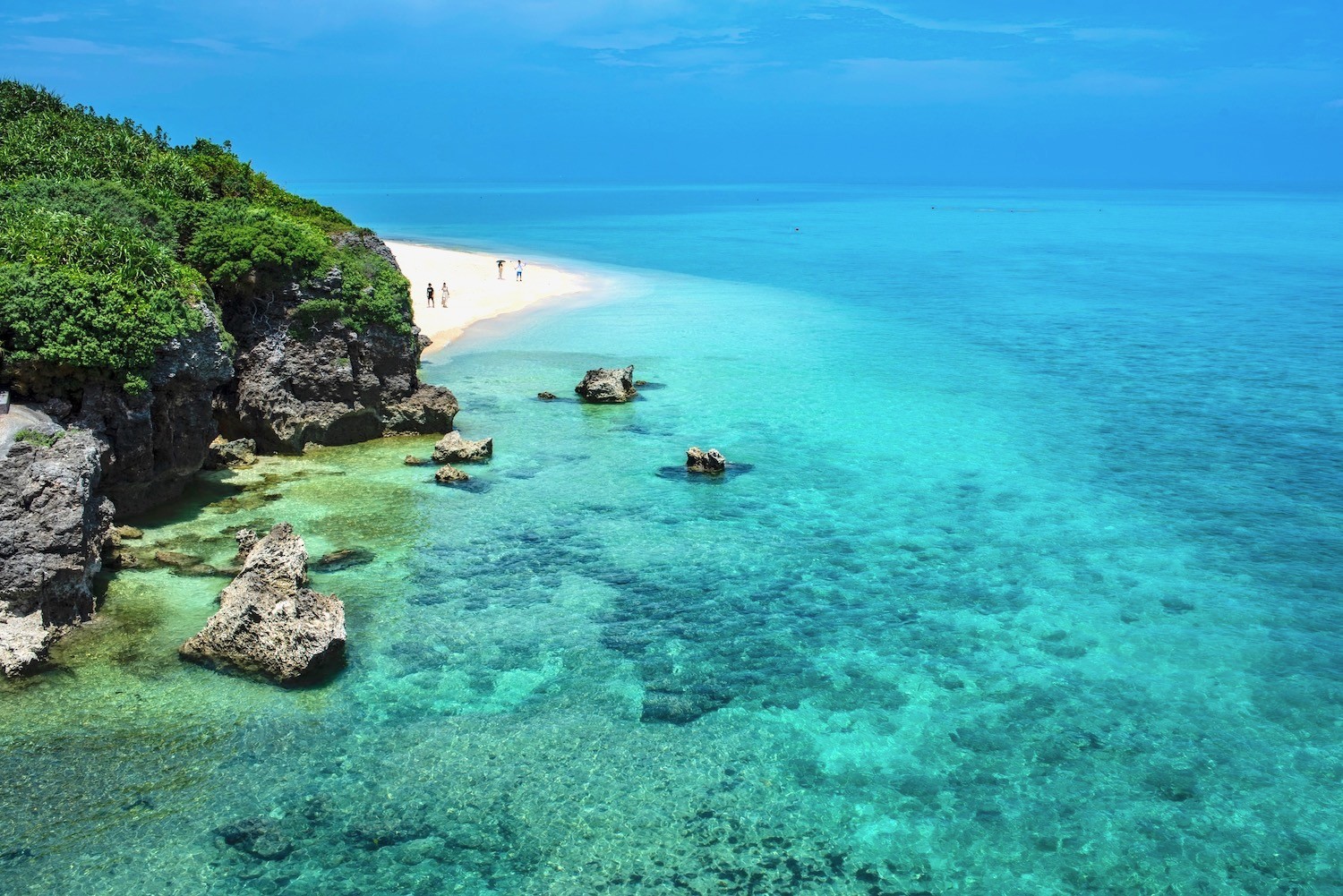 Kabira Bay Ishigaki Okinawa Japan Tourism Offers Glass Bottom Boat Tours
Kabira Bay Ishigaki Okinawa Japan Tourism Offers Glass Bottom Boat Tours
- Aharen Beach (Tokashiki Island): Known for its crystal-clear waters and vibrant coral reefs, Aharen Beach is perfect for snorkeling and diving. The beach offers a range of amenities, including rental shops and cafes, ensuring a comfortable visit.
- Emerald Beach (Okinawa Main Island): Located within the Ocean Expo Park, Emerald Beach features soft, white sand and calm waters, making it ideal for families. The beach is divided into zones for swimming, playing, and relaxing, catering to different preferences.
- Yonaha Maehama Beach (Miyakojima): Renowned for its powdery white sand and clear turquoise waters, Yonaha Maehama Beach is consistently ranked among Japan’s best beaches. It’s an excellent spot for swimming, sunbathing, and water sports.
- Sunayama Beach (Miyakojima): Famous for its unique natural rock arch and pristine sands, Sunayama Beach is a picturesque location for relaxation and photography.
2.2. Diving and Water Activities: Where Can I Experience Okinawa’s Underwater World?
Okinawa offers world-class diving and snorkeling opportunities, with vibrant coral reefs and diverse marine life. For Okinawa Japan tourism focused on water activities, consider these top spots:
- Kerama Islands: A short ferry ride from Okinawa Main Island, the Kerama Islands are renowned for their crystal-clear waters and abundant marine life. Popular dive sites include “The Garden” and “The Tower,” offering encounters with sea turtles, colorful fish, and vibrant coral formations.
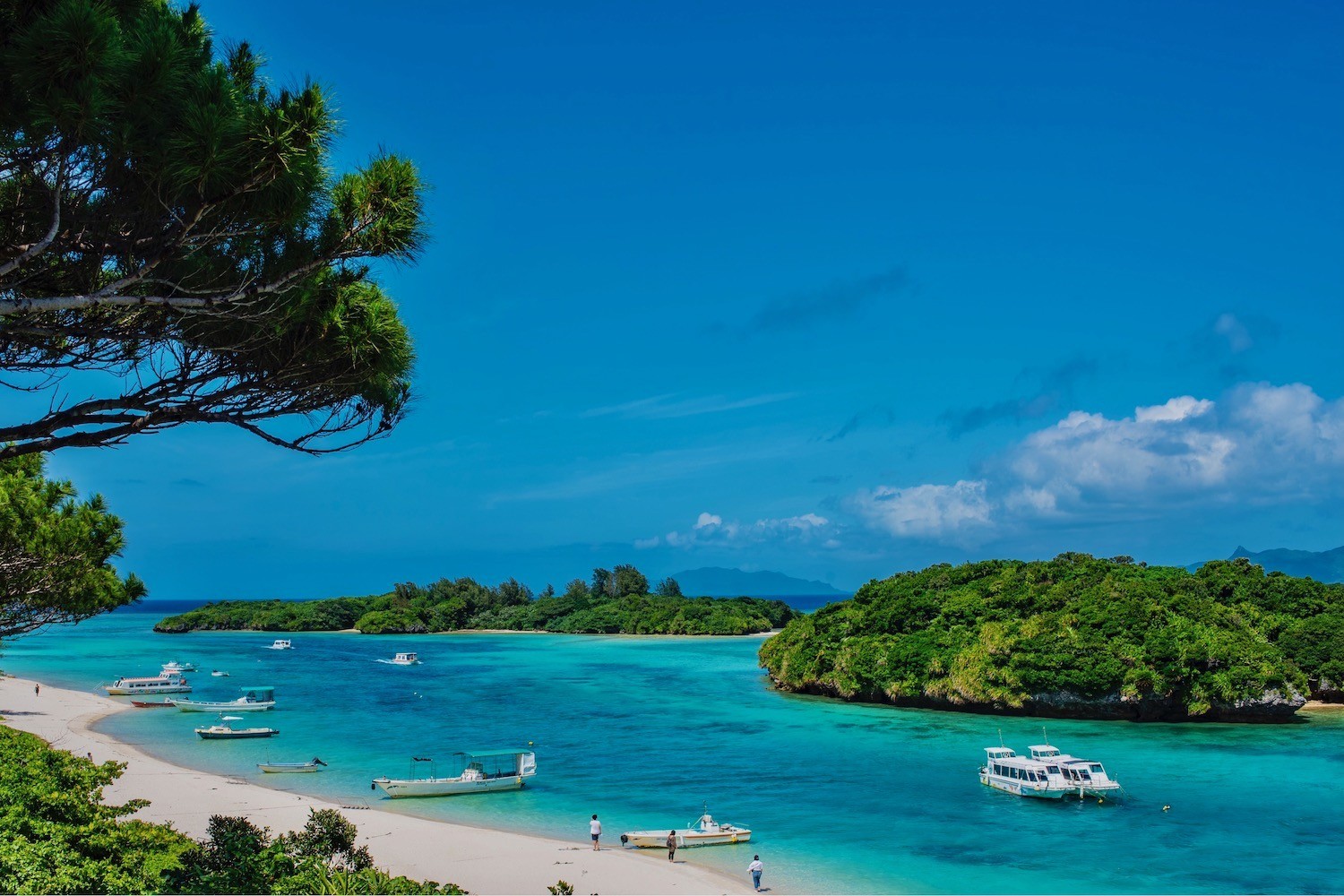 Ishigaki Okinawa Japan tourism divers underwater exploration
Ishigaki Okinawa Japan tourism divers underwater exploration
- Yaeyama Region (Ishigaki, Iriomote): The Yaeyama region boasts pristine coral reefs and diverse marine ecosystems. Ishigaki Island offers excellent diving and snorkeling spots, including Manta Scramble, where you can witness manta rays in their natural habitat. Iriomote Island, with its lush mangrove forests and diverse marine life, is also a must-visit for nature enthusiasts.
- Miyakojima: Known for its underwater caves and unique geological formations, Miyakojima offers thrilling diving experiences. Popular dive sites include the “Triangle Hole” and “Mini Grotto,” providing opportunities to explore stunning underwater landscapes.
According to the Okinawa Prefectural Government, the region’s commitment to marine conservation has helped preserve its underwater ecosystems, making it a top destination for divers and snorkelers. Keep in mind that Japan has strict regulations regarding diving licenses. If you do not have yours, you will be limited to snorkeling.
2.3. Hiking and Nature Trails: Which Hikes Offer Stunning Views?
Beyond its beaches, Okinawa offers scenic hiking trails that showcase the island’s natural beauty and historical sites. For Okinawa Japan tourism, explore these hiking destinations:
- Nakijin Castle Ruins: A relatively short hike leads to the ruins of Nakijin Castle, a UNESCO World Heritage site. The castle offers panoramic views of the surrounding coastline and forests, providing a glimpse into Okinawa’s rich history.
- Shuri Castle: Located in Naha, Shuri Castle was the royal residence of the Ryukyu Kingdom. While a fire in 2019 caused significant damage, the castle remains a significant historical site, and the hike to the keep offers stunning views of the city.
- Mount Gusuku (Ie Island): A hike up Mount Gusuku on Ie Island rewards you with breathtaking views of the island and surrounding ocean. The trail is relatively easy, making it accessible for most hikers.
- Mount Omoto (Ishigaki Island): The highest peak in Okinawa Prefecture, Mount Omoto offers challenging but rewarding hikes with stunning panoramas and crystalline waterfalls. The trail passes through lush forests and provides opportunities to observe diverse wildlife.
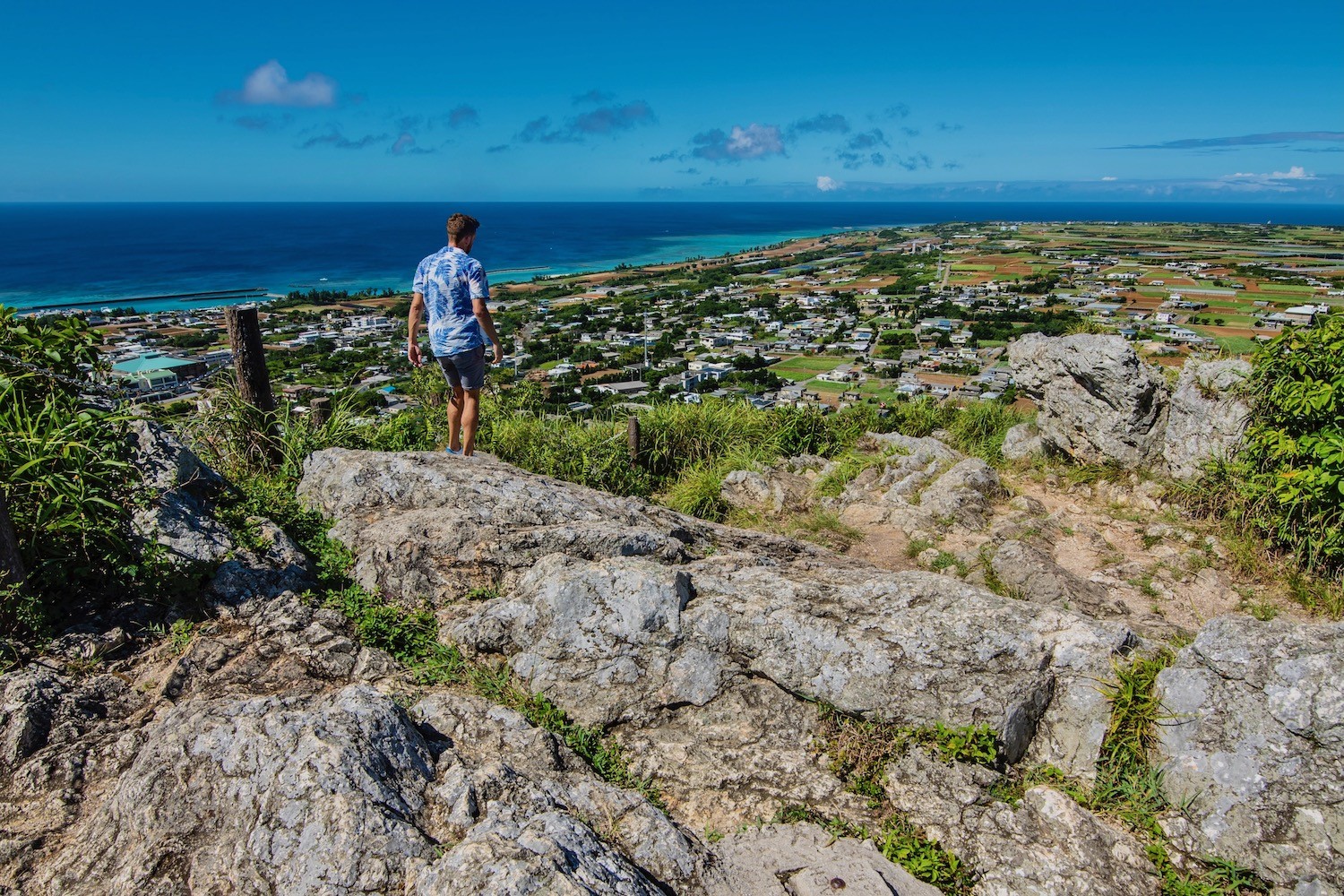 Mount Gusuku Ie Island Okinawa Japan Tourism Offers Stunning Panoramas
Mount Gusuku Ie Island Okinawa Japan Tourism Offers Stunning Panoramas
2.4. Culinary Delights: What Local Dishes Should I Try?
Okinawa’s cuisine is a unique blend of Japanese, Chinese, and Southeast Asian influences, offering a diverse range of flavors and ingredients. For Okinawa Japan tourism, don’t miss these local specialties:
- Okinawa Soba: A comforting noodle soup featuring thick, wheat-flour noodles in a pork-based broth, topped with tender pork belly, fish cake, and scallions. This is a must-try dish that showcases Okinawa’s culinary heritage.
- Taco Rice: A fusion dish created in Okinawa, Taco Rice consists of taco fillings (seasoned ground beef, lettuce, tomato, and cheese) served over a bed of rice. This dish is a local favorite that reflects Okinawa’s American influences.
- Goya Champuru: A stir-fry dish made with goya (bitter melon), tofu, pork, and egg. This healthy and flavorful dish is a staple of Okinawan cuisine, known for its nutritional benefits and unique taste.
- Umibudo (Sea Grapes): A type of seaweed that resembles tiny grapes, Umibudo is a delicacy in Okinawa. It is typically served with soy sauce or vinegar and is known for its refreshing, slightly salty taste and unique texture.
- Rafute: Braised pork belly that has been simmered in soy sauce, sugar, and awamori (Okinawan rice liquor) until tender and flavorful. Rafute is a popular dish served at special occasions and festivals.
- Miyako Shrimp Truck: Drawing inspiration from Hawaii, Miyakojima offers delicious shrimp plates from food trucks. Enjoy fresh, locally sourced shrimp prepared with various seasonings and sauces.
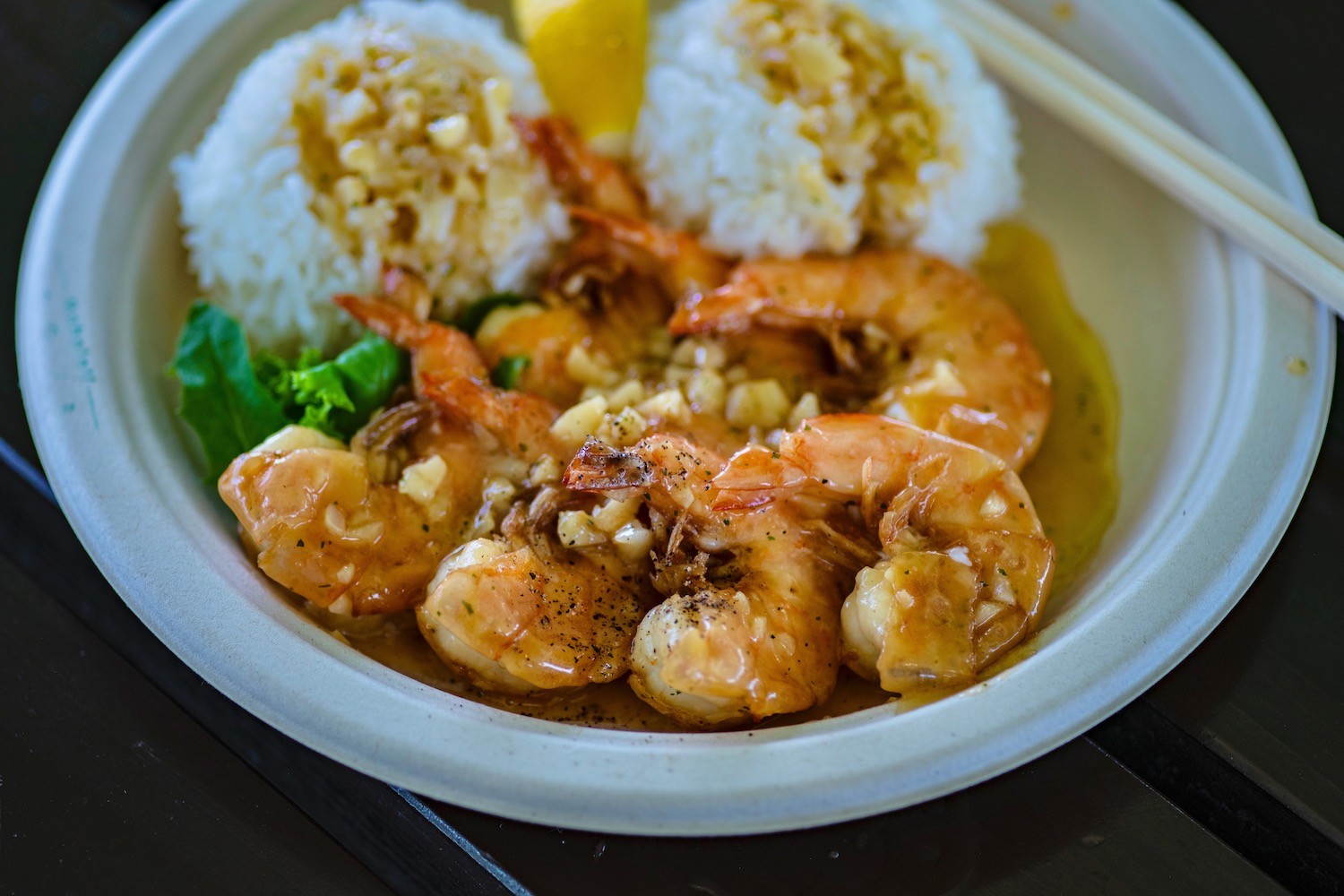 Miyako Shrimp Truck Okinawa Japan Tourism Shrimp food truck
Miyako Shrimp Truck Okinawa Japan Tourism Shrimp food truck
2.5. City Exploration: What Can I Do in Naha?
Naha, the capital city of Okinawa, offers a mix of historical sites, cultural attractions, and modern amenities. For Okinawa Japan tourism, explore these urban highlights:
- Shuri Castle: A UNESCO World Heritage site, Shuri Castle was the royal palace of the Ryukyu Kingdom. Explore the castle grounds, admire the intricate architecture, and learn about Okinawa’s rich history.
- Shikina-en Garden: A serene and beautiful garden featuring traditional Ryukyuan architecture, ponds, and lush vegetation. Shikina-en offers a peaceful retreat from the city and provides a glimpse into Okinawa’s cultural heritage.
- Naminoue Shrine: Perched on a cliff overlooking the ocean, Naminoue Shrine is a unique and picturesque Shinto shrine. Visit the shrine to admire the stunning views and experience Okinawa’s spiritual side.
- Kokusai-dori Street: A bustling international street lined with shops, restaurants, and entertainment venues. Kokusai-dori is a great place to sample local cuisine, purchase souvenirs, and experience Okinawa’s vibrant atmosphere.
- Okinawa Prefectural Museum & Art Museum: Discover Okinawa’s history, culture, and art at this comprehensive museum. Explore exhibits showcasing artifacts, artworks, and historical documents related to the Ryukyu Kingdom and Okinawa Prefecture.
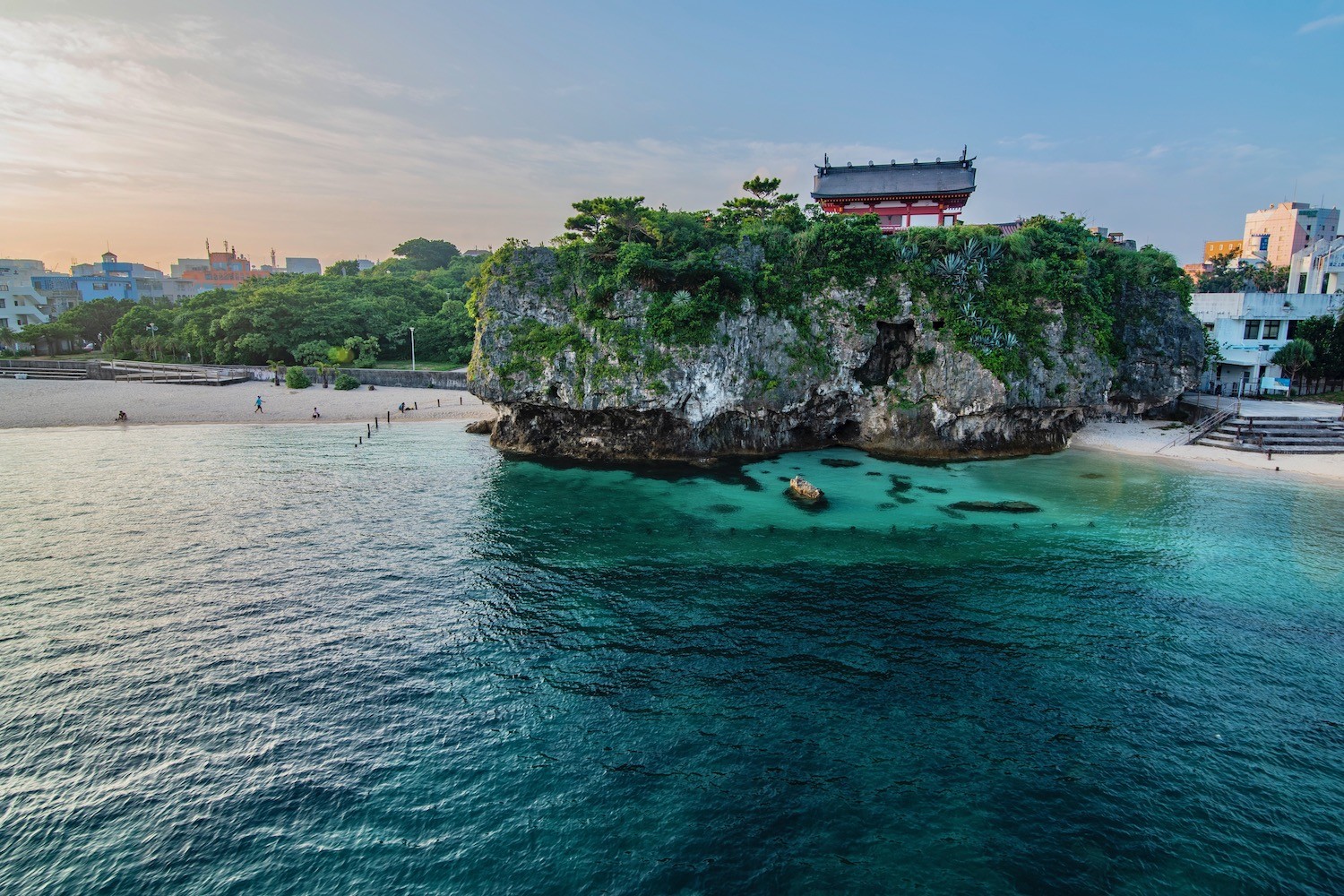 Naminoue Shrine Okinawa Japan Tourism Naha city
Naminoue Shrine Okinawa Japan Tourism Naha city
3. Where Should I Stay in Okinawa for the Best Experience?
Okinawa offers a range of accommodation options, from luxurious beach resorts to budget-friendly city hotels. Consider these factors when choosing where to stay for your Okinawa Japan tourism trip:
- Naha: Ideal for those who want to explore the city’s attractions and have easy access to transportation. Naha offers a variety of hotels, guesthouses, and apartments to suit different budgets.
- Resort Areas (e.g., Onna, Nago): Perfect for travelers seeking a relaxing beach vacation with access to resort amenities, water sports, and natural beauty. These areas offer a range of high-end resorts, boutique hotels, and villas.
- Ishigaki: A great base for exploring the Yaeyama Islands and enjoying diving, snorkeling, and beach activities. Ishigaki offers a mix of hotels, guesthouses, and resorts.
- Miyakojima: Ideal for those who want to experience pristine beaches, unique landscapes, and a more laid-back atmosphere. Miyakojima offers a range of hotels, villas, and rental apartments.
Some recommended hotels include:
- Hyatt Regency Seragaki Island: An upscale resort offering luxurious accommodations, stunning ocean views, and a range of amenities, including pools, restaurants, and a spa.
- West Inn Naha: A budget-friendly hotel in Naha, offering comfortable rooms and a convenient location near the monorail and city attractions.
- Hotel WBF Porto Ishigaki: A stylish hotel in Ishigaki, offering modern rooms and a convenient location near the port and city center.
- Hotel Pink Hibiscus Miyakojima: A charming hotel in Miyakojima, offering comfortable rooms and a friendly atmosphere.
4. Is Okinawa Overrated? What Should I Expect?
Okinawa’s reputation as a tropical paradise sometimes leads to high expectations. While the islands offer stunning natural beauty and unique cultural experiences, it’s essential to have realistic expectations for your Okinawa Japan tourism trip.
Okinawa offers a distinct blend of Japanese, Chinese, and Southeast Asian influences, which can be different from mainland Japan. Some visitors may find the pace of life more relaxed, and the cultural experiences less polished than in other parts of Japan. Furthermore, Okinawa’s weather can be unpredictable, especially during typhoon season. It’s essential to check the forecast and be prepared for potential disruptions to your travel plans.
Despite these considerations, Okinawa remains a worthwhile destination for those seeking beautiful beaches, unique culture, and natural beauty. While the islands are honestly best visited on a weekend trip if you’re staying in Japan or a nearby Asian country like Taiwan for a while.
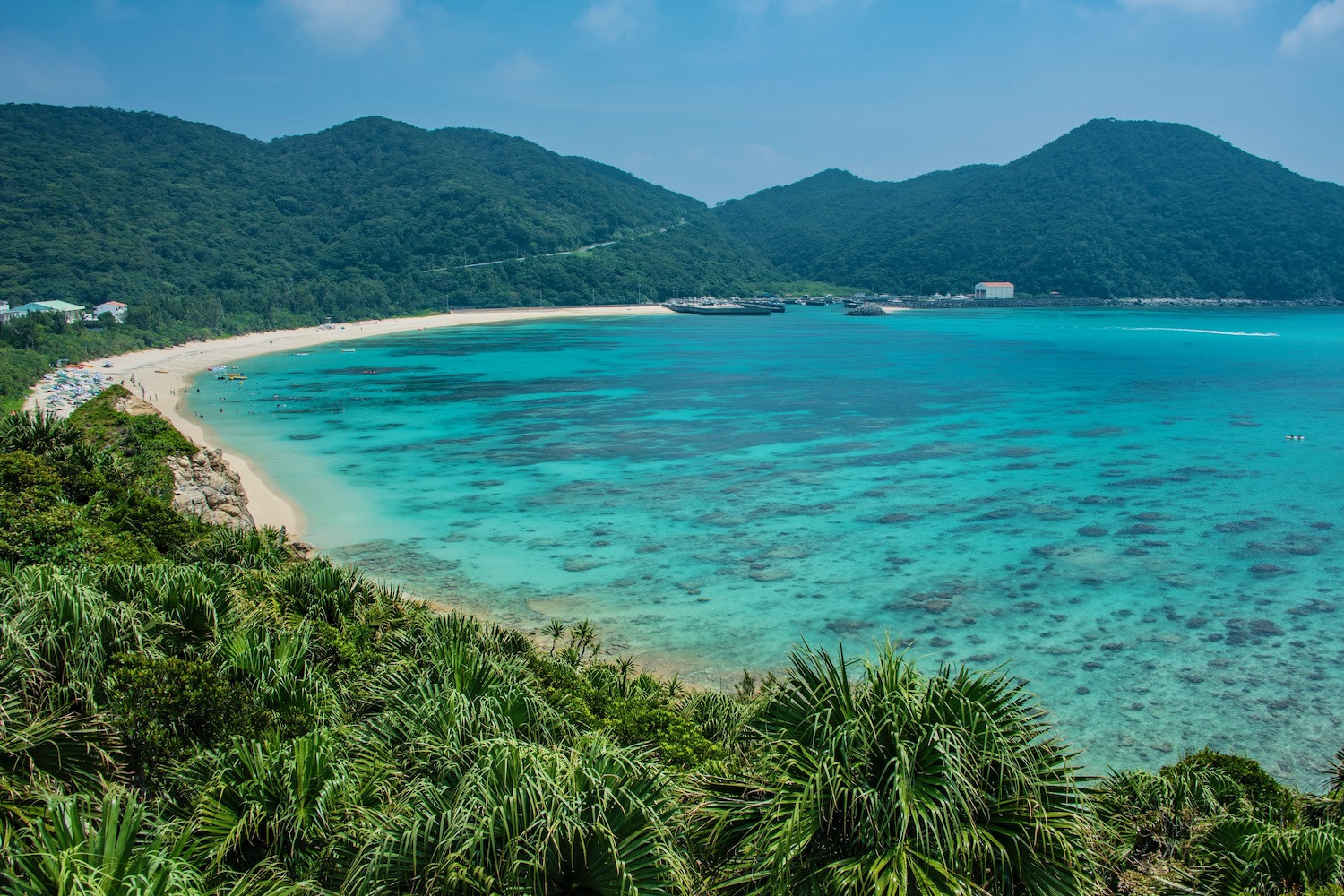 Tokashiku Beach Okinawa Japan Tourism Offers Pristine Beaches
Tokashiku Beach Okinawa Japan Tourism Offers Pristine Beaches
5. What Are Some Frequently Asked Questions About Okinawa Japan Tourism?
Here are some common questions travelers have about visiting Okinawa:
5.1. Does Okinawa Get Cold?
Yes, Okinawa can get cold, especially during the winter months (December to March). Temperatures can drop to around 15-20°C (59-68°F), and the wind can make it feel even colder. While it’s not freezing, it’s not ideal for swimming, and you’ll need to pack warm clothing.
5.2. Do You Tip in Okinawa?
No, tipping is not customary in Okinawa, as is the case throughout Japan. If you try to tip, Okinawans will likely refuse or chase after you to return the money. It’s best to avoid tipping altogether.
5.3. What is the Best Area to Stay in Okinawa?
The best area to stay in Okinawa depends on your preferences and travel style. Naha is convenient for exploring the city, while resort areas like Onna and Nago are ideal for beach vacations. Ishigaki is a great base for exploring the Yaeyama Islands, and Miyakojima offers a more laid-back atmosphere with pristine beaches.
5.4. Is It Easy to Get Around Okinawa?
Getting around Okinawa is relatively easy, with various transportation options available. Renting a car is recommended for exploring the islands, especially outside of Naha. Public transportation, including buses and monorail, is available in Naha but may be less frequent in other areas.
5.5. Are There Any Cultural Differences I Should Be Aware Of?
Okinawa has a unique cultural heritage influenced by its history as the Ryukyu Kingdom. Some cultural differences to be aware of include:
- Language: While Japanese is the official language, Okinawan dialects are still spoken in some areas.
- Religion: Okinawa has a mix of Shinto, Buddhist, and indigenous beliefs.
- Customs: Okinawans are known for their hospitality and laid-back attitude.
5.6. What Kind of Travel Insurance Should I Get for Visiting Okinawa?
Travel insurance is crucial for your Okinawa Japan tourism trip to protect against unforeseen circumstances. SafetyWing’s Nomad Insurance is a great choice for affordable, flexible, borderless travel medical insurance. Their Essential and Complete plans offer coverage for emergency medical situations and full-scale global healthcare, including travel coverage.
5.7. What Are Some Good Souvenirs to Buy in Okinawa?
Okinawa offers a variety of unique souvenirs to commemorate your trip:
- Awamori: Okinawan rice liquor, a local specialty.
- Ryukyu Glass: Handcrafted glassware with vibrant colors and unique designs.
- Shisa Statues: Traditional Okinawan lion-dog statues believed to ward off evil spirits.
- Beni Imo (Purple Sweet Potato) Products: A range of snacks, sweets, and desserts made from Okinawa’s famous purple sweet potato.
- Textiles (Minsa Weaving): Textiles with intricate patterns and vibrant colors, reflecting Okinawa’s cultural heritage.
5.8. Are There Any Festivals or Events I Should Know About?
Okinawa hosts various festivals and events throughout the year, showcasing its culture and traditions. Some notable events include:
- Naha Hari (Dragon Boat Race): Held in May, this exciting dragon boat race features teams competing in traditional Okinawan boats.
- Okinawa Zento Eisa Matsuri: A vibrant Eisa dance festival held in August, featuring traditional Okinawan drumming and dance performances.
- Shuri Castle Festival: Held in autumn, this festival celebrates Okinawa’s history and culture with traditional performances, ceremonies, and exhibitions.
5.9. What is the Currency Used in Okinawa?
The currency used in Okinawa is the Japanese Yen (JPY). Credit cards are widely accepted in major establishments, but it’s always a good idea to have some cash on hand for smaller shops, restaurants, and transportation.
5.10. What Are the Visa Requirements for Visiting Okinawa?
Visa requirements for visiting Okinawa depend on your nationality. Many countries have visa waiver agreements with Japan, allowing their citizens to stay for up to 90 days without a visa for tourism purposes. Check the Japanese Ministry of Foreign Affairs website for the latest visa information.
6. The Bottom Line: Why Should You Visit Okinawa with SIXT.VN?
Okinawa Japan tourism offers a unique blend of stunning beaches, vibrant culture, and historical sites. While it’s essential to have realistic expectations, Okinawa remains a worthwhile destination for those seeking a memorable travel experience.
SIXT.VN is your trusted partner for planning your dream trip to Okinawa. We offer a range of services to make your journey seamless and enjoyable, including:
- Expert Travel Consulting: Personalized travel itineraries tailored to your interests and preferences.
- Airport Transfer Services: Convenient and reliable airport transportation to your hotel.
- Hotel Booking: A wide selection of accommodations to suit your budget and location preferences.
- Tour and Activity Reservations: Access to the best tours, activities, and attractions in Okinawa.
- Flight Booking: Assistance with booking flights at the best prices and schedules.
With SIXT.VN, you can relax and enjoy your Okinawa adventure, knowing that all your travel needs are taken care of. Let us help you create unforgettable memories in this beautiful island paradise.
Ready to start planning your Okinawa adventure? Contact SIXT.VN today!
Address: 260 Cau Giay, Hanoi, Vietnam
Hotline/Whatsapp: +84 986 244 358
Website: SIXT.VN



